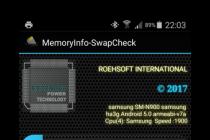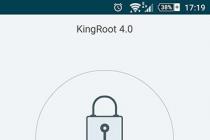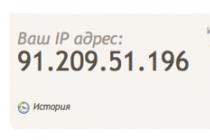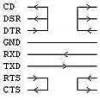Most mobile phones refuse to charge after a certain period of time. This problem can occur on both old and new models. There are also times when the battery charges very slowly. What is causing these problems? We will answer this question in this article.
Reason 1: Damaged cable
Often there comes a moment when the charger burns out, breaks in certain places and simply stops supplying energy. The first thing to do when not charging is to check the phone's USB cable. If suddenly the wire is damaged, then the gap should be glued with electrical tape. A defect of this kind is shown in the figure below.

Sometimes the cause can be debris that has accumulated in the tips of the charger. To clean hard-to-reach places, you need to use a toothpick or a simple match. A paint brush is also suitable, which you need to walk along the inside.

In order to exclude these options, you should try to charge your cell phone with another cable. You may need to buy a new device. But if the problem is not solved, then the reason lies elsewhere.
Reason 2: Charging socket
The problem may be in the phone itself, or rather in the charger connector. The following shows the types of connectors that are separated from the mobile.

To exclude this option, you need to try to charge the phone's battery itself. To do this, you need a special device that separately charges the batteries. An example of such a cable is shown in the figure below.

You can try this method on other phones where there is exactly the same battery. You can also use homemade devices. It's pretty easy and fast to make. You will need two ordinary wires, which you need to connect to the battery contacts (the actions are shown by the red arrow in the figure below). You can connect all this with a simple electrical tape.

Reason 3: Damaged battery
After a certain period of time, mobile phone batteries begin to fail. To solve the problem, you simply need to replace it with a new battery and try to charge the cell again. Sometimes you can take the battery out and then put it back in. Such a simple method in most cases is quite useful. It often happens that various bulges and irregularities begin to appear on the battery. It is impossible to restore the battery after this, as corrosion has taken over. You will need to buy a new battery, as the old ones can cause corrosion on the phone itself, which is undoubtedly worse.
Owners also face the problem of battery swelling (the result is shown in the image below). Batteries reach this state very rarely, but if the swelling procedure has begun, then it will no longer end.

Reason 4: Violations in the system
The problem can also occur due to the software of the phone. This is often found in Android phones.

In order to eliminate all suspicions, you should perform the following steps:
1) End all active processes, including Internet connection, bluetooth, geolocation and wi-fi;
2) Download and install applications to optimize the system. The best include programs such as: SmartManager and Clean Master. Thanks to them, you can significantly reduce the load from installed utilities on individual places in the system;
3) Restore the system with the latest correct settings. In many phones, this method performs differently, but the Recovery application will be the right solution;
4) Flash the phone. Many phone owners try to use amateur firmware downloaded from the Internet. This is what can become a problem. To solve it, you need to install the official firmware, which can be downloaded from the manufacturer's website.
Reason 5: Battery Calibration
Mobile phone users may also face the problem of slow charging. For example, the power supply process takes a long time, or the charging indicated on the phone does not correspond to the time of use. To solve this problem, you just need to calibrate the battery. You will need to follow four simple steps, detailed below:
1) We bring the charging of the phone to a complete shutdown. The device should turn off automatically;

2) We remove the battery from the cell phone and put it aside for several minutes;

3) Insert the battery back;
4) Connect the phone to the charger. You don't need to turn on your mobile.

5) Remove the battery again and insert the phone back without turning it on. After completing all the steps, you can turn on the device.
If all the above described solutions did not turn out to be useful, then you should take the mobile phone to a service center, where they will check it and eventually make repairs.
In the modern world, a smartphone is an indispensable thing, so when your favorite gadget takes a long time to charge or does not turn on at all, it becomes a whole problem, especially if it is a new phone.
First of all, we think about how to charge our gadget, especially when we are in a hurry and look for the causes of problems in the phone, but before that, you should also carefully examine the related equipment:
- Socket - if the wiring is old or there are some other problems with electricity, then this may well explain why the gadget either charges or not;
- Charger - check its integrity, it may be damaged;
- Incompatibility of the charger with the gadget - if the inputs are similar, this does not mean that the charger is suitable for both smartphone models.
If you are convinced that you do not have any of the above problems, you can proceed to the study of the phone itself. We will look at the most common reasons why the phone does not accept a charge.
The gadget is charged only from the computer
When the phone is charged only from the computer, but the smartphone is turned on and works normally, it is worth checking the charger. But if the charging is in order, and the smartphone does not see it or writes that charging is in progress, but in fact it is not, there is a malfunction in the phone.
In some cases, flashing the gadget or replacing the input helps, but only a professional can do this after they examine the device and fix the problem.
What to do if the phone does not charge, but the charger is connected
It happens that the phone shows charging, but does not charge, and even after several hours of recharging, the battery remains at zero. Or, if you do not charge the phone for a long time, the battery does not accept a charge. In both cases, there may be several reasons:
- Charging does not charge;
- The phone's battery is defective;
- Many applications and other services are open.
If the case is in the charger, the gadget detects the charger, but due to technical malfunctions it does not charge. This situation is probably known to the owners of the iphone, since the cable malfunctions from frequent use. Try replacing the wire, maybe that's the issue.
In the case when the problem lies in the battery, you will have to buy a new one or even turn to the master, you see, in such smartphone models as Samsung Galaxy S6, LG Optimus Vu, HTC One X, the battery is built-in, which means that you cannot replace it yourself.
The latter option is very rare, but still has a place to be, especially if you are the owner of a DNS or Fly smartphone. In this case, you just need to close all programs, in particular Wi-Fi, the Internet and your favorite games, and then leave your android alone while it is charging. If the indicator shows that the charge is on, you can congratulate yourself, you just fixed the problem.
Bad contact contact
You are familiar with the situation when the phone is working and charging is in order, but for some reason the smartphone does not respond to the device when connected to the network. You don’t know what to do anymore, because the phone doesn’t charge for a very long time, but the reason for this can be banal.
From time to time, dust gets into a cell with a removable battery, especially for older Samsung models. If you do not clean the inner surface, dirt accumulates, creating a layer that prevents the contacts from mating normally, which is why the phone does not charge. Try removing the battery, then clean it and the inside of the case with a Q-tip. Also pay attention to the "teeth", if they are slightly bent, correct this using a match, but be careful not to damage the contacts.
The phone does not charge from the charger
When the phone does not charge from charging, the cause should be sought in the charger or in the gadget's connector. In this case, it’s very easy to find out what really doesn’t work, just connect the mobile phone to a PC or use the “frog” universal charger, but it will be problematic to use it every day, because you have to turn off the phone every time and pull out the battery. Another way to charge the phone from an external battery, but this is also not an everyday option.
Smartphone charging backwards
Not everyone knows why the charging goes in the opposite direction, and at the same time the phone does not take a charge, but, as it were, gives it away. Faced with such a situation, many are simply perplexed. The reason for this unusual phenomenon is simple - a failure in battery calibration, this happens from time to time with Lenovo phones, but do not panic, because the problem can be solved very quickly.
To eliminate the anomaly, first you need to discharge the battery to such an extent that the smartphone turns itself off. After that, remove the battery for a couple of minutes and put it back in the phone. Connect the gadget to the charger, but do not turn it on until the charge is on.
Phone takes a long time to charge
If your smartphone has been on charge all night, but it is not fully charged or the indicators are not more than 1 percent, then the problem lies in the battery. Of course, for the first time, you can even charge the phone up to 100 percent, but not only will the process take a long time, but the gadget will be discharged in just a couple of hours, if not earlier.
In this case, you have only one way out - to buy a new battery and then safely use your irreplaceable gadget.
You can figure out the problem yourself, but if you didn’t manage to find out why the phone is not charging and you have tried almost all of the above methods, it is best to take the smartphone to the master, because only a specialist can establish the true cause of the malfunction.
The battery capacity of most Android smartphones and tablets allows you to actively use the device without recharging for 12-24 hours. The charging time of the device is two to three hours. But sometimes the gadget abruptly drops the charge level, quickly discharges, loses the battery charge level when connected to a power outlet, or completely stops responding to the charger being connected. If your smartphone has stopped charging, explore the possible causes and solutions for this situation.
What to do if your Android phone or tablet is not charging. Possible reasons
Common reasons for the lack of charging are a breakdown of the power supply or microUSB connector, battery wear, and software failures. Realizing that the smartphone or tablet is not charging, first of all check the voltage on the contacts of the battery and charger. If everything is in order, use other methods to restore your smartphone or tablet.
Indicates that charging is in progress, but not charging from the network
If, when connected to a power outlet, the indicator shows the charging process, and when you disconnect the cable, the smartphone or tablet turns off, the charge level controllers have probably shorted. A short circuit occurs as a result of water entering the case or a broken connector.

Try testing the device with a different cable and battery - if the result is the same, take your smartphone or tablet to a service center. Specialists will find and replace the defective element.
The percentage of charge does not change via USB from the computer
Users often charge smartphones and tablets from a laptop rather than from an outlet. Reasons why a smartphone with a good battery does not receive power from a computer:
- rupture or insufficient cable thickness;
- insufficient current for charging;
- the connection is blocked by the PC operating system;
- USB charging is disabled in the device menu.

Finding a broken wire, connect the two torn ends together and rewind with electrical tape. If the current supplied to the USB port is not sufficient for charging, try connecting the device to a different port.
More often than others, the Ubuntu operating system blocks charging. To bypass the blocking, blacklist your smartphone along the path /etc/default/tpl.
Fully discharged and not charging
Smartphones and tablets do not respond to the connection of the charger when the battery is deeply discharged. If the gadget has been discharged more than a day ago and does not show signs of life, plug it into an outlet and leave it off. After 10 minutes, check if the charge indicator is on. If yes, you can turn on the device.
If the indicator does not light up, clean the contacts of the Micro USB connector and plug on the charger cable. Take a thick needle and use the reverse end to remove small dust particles and spools. Insert the plug into the socket and leave the smartphone or tablet for another 10 minutes.
A common situation when users suspect problems with charging is display failure. At the same time, the gadget is charging, but you do not see it - the screen remains dark. To check whether charging is in progress or not, use the indicator light on the case. If there is no indicator, turn on the device. If the display breaks, you will hear the characteristic sound of the system starting up, and if the charging connector does not work, the gadget simply will not turn on.
Stopped charging from cigarette lighter
When charging your smartphone in the car, you may encounter the problem of not being charged from the cigarette lighter. First of all, try connecting another device and check the fuse box in the car. It is possible that the one that is responsible for supplying current to the cigarette lighter socket has burned out. If the fuse is OK, disassemble the charger plug and check the condition of the fuse.

If the battery indicator is displayed on the screen, but the charge level does not increase or even drops, it means that the cigarette lighter is receiving low current, insufficient to power a smartphone or tablet.
The device blinks but does not charge
Smartphones and tablets equipped with a color indicator flash during charging. If your indicator flashes unusually while charging (for example, it was always blue, but now it is flashing green and red alternately), and the device is discharging, the problem may be in the processor overheating. In this case, restart your tablet or smartphone in Recovery mode and try to charge it. If the situation does not improve, clean the connector and plug contacts and reconnect the cable. A continued flashing indicates that it is time to replace the battery with a new one.
Video - What to do if the smartphone is not charging
Problems when charging a smartphone or tablet
The problems of modern gadgets are connected not only with the lack of charging when the cable is connected. It happens that a tablet or smartphone is charging, but then the charge level drops sharply, or the device turns off when the battery rate is 90% and stops turning on. The recommendations below will help you deal with the problem.
Charges only when turned off
After a fall or software failure, the smartphone can only accept charging when it is turned off. Solutions to the problem:
- factory reset;
- flashing the device.

If the software methods do not help, the Micro USB connector may be damaged, and the help of a service center specialist is required.
Charging but not completely
If the power indicator is displayed, but the smartphone does not show a 100% battery level, the battery needs to be calibrated. The second reason is insufficient current for a full charge. Check the charger for cable integrity and if necessary, change to a 2-amp model with a thicker cord.

If the suggested methods do not help, replace the battery with a new one.
Not charging more than 1%
In a situation where the charge percentage does not rise more than 1%, check chargers with other gadgets and try charging your smartphone or tablet from a computer. If it doesn't help, replace the battery with a new one.
Doesn't charge until rebooted
Incorrect charging of gadgets is often associated with software. If your smartphone does not charge without rebooting or reboots during the charging process, follow these steps:
- remove unnecessary programs from the system that can affect the charging process;
- rollback to default settings;
- connect another cable;
- reflash the device.
The device runs out of power when turned off
For a working battery, it is normal to gradually reduce the charge level even when the smartphone or tablet is turned off - by about 1% per week. But if you turned off the device at night with a 100% charge level, and turned it on in the morning and saw a value of 50%, most likely you need to replace the battery. If the replacement does not work, the problem is in the processor - take the device to a service center.
The device is charging, but shows an incorrect charge value
When the charge indicator displays an incorrect value - for example, it shows 50%, and turns off after a minute and displays 0-5% when it is turned on again, battery calibration helps. To calibrate the battery:
- Discharge your smartphone or tablet. When it turns off, turn it back on and wait for it to turn off. Do this until the device starts to turn off after a second of active mode.
- Take the battery out for five minutes and put it back in.
- Connect the charging cable to your gadget. Charge it without turning it on.
- Remove the battery again for 5 minutes without turning on the device.
- Install the battery and turn on your smartphone/tablet.
If manually calibrating doesn't help, try downloading a calibrator app.
Why does an Android phone or tablet drain quickly?
Android gadgets keep the charge level throughout the day. If your device is running out of power faster and you need to extend the battery life, use the recommendations below.
What processes contribute to the discharge of the battery
The charge level is affected by screen brightness and communication modules. You can optimize battery consumption by making a number of settings. Go to device settings and disable the following features:
- 4G connection - 4G networks do not work in all regions, and when the option is connected, the smartphone is in constant network search mode;
- bluetooth - connect only for file transfer;
- wi-fi - increases charge consumption by 15%;
- gps - needed only for navigation and positioning;
- auto-rotate display - the function uses the accelerometer and gyroscope, consuming energy;
- vibration response to touch.

Close applications running in the background. If you use the launcher and themes, disable them. Also turn off automatic sync and app updates.
The device charges quickly and discharges quickly
If the smartphone is quickly discharged and just as quickly charged, the problem lies in the battery. Try to charge the phone to 100%, then discharge it until it turns off, and so on several times. If the battery does not charge better, replace it with a new one.
The device takes a long time to charge and discharges quickly
How long it takes to charge a smartphone or tablet depends on the power source. It is not recommended to use universal cables to power the device - the current strength may be insufficient and charging will be slow.
If you are using the original charger, but the battery level is growing slowly, try charging the device that is turned off. If 2-3 hours after turning off the phone, the charge indicator shows 100%, look for problems with the software. If charging the switched off gadget takes longer, the problem is in the hardware.
Charging a cold battery is slower, so do not connect the cable to the phone immediately upon returning from the cold. Wait for the machine to warm up to room temperature.
The gadget is quickly discharged in standby mode
In standby mode, the battery is consumed by the accelerometer and gyroscope. They are designed to control the movements of the device relative to the ground and the human body. To decrease the level more slowly, disable the sensors. Also close background applications. To do this, go to the "Settings" menu, select "Applications" and on the "Running" tab, stop unnecessary ones.
If the actions with the software do not help, there may be damage to the motherboard. In this case, the smartphone or tablet needs to be repaired.
Battery drops sharply
Changes in charge level values do not give the user the opportunity to figure out how long a smartphone or tablet will last without recharging. If you're worried about battery fluctuations, try manually calibrating your battery or using the Battery Calibrator app.
When calibration does not help, connect a light bulb directly to the battery contacts and wait until it stops shining. Then install the battery in the smartphone and charge it to 100%. After repeating the procedure three times, the charge level will be displayed more evenly.
The charge began to sit down quickly after the update
Software updates require more power from smartphones and tablets, and therefore consume battery faster. If after the update your gadget began to discharge faster, perform a factory reset, after saving important information.
Another common cause is a virus that got into the phone with an update. Find the virus program and remove it. To do this, use an antivirus - Kaspersky, McAfee or Dr. Web.
How to check battery status
There are various ways to check the battery status.
|
Method name |
Implementation |
| Digital team | ·
In the dialing mode, enter the combination *#*#4636#*#* and select "Battery Information".
· use the Battery application - it displays information about the battery status: voltage, temperature and other parameters. |
| External inspection (if the battery is removable) | · Disconnect the battery and inspect for bulges. If the battery is swollen, it means that it is out of order and needs to be replaced. · If there are no visible irregularities, place the battery on a table and rotate it. A working battery will make a couple of turns and stop, and a worn one will spin for a long time. |

During charging, you can see a question mark on the battery icon - it appears when the battery is worn out, notifying you of the need for replacement, or in cases where the plug contact comes off.
How to charge an Android device with a broken connector
Charging problems are often associated with a broken Micro USB connector. If it is out of order, and you need to extend the life of the gadget, use a wireless charger. Attach the receiver to the battery and turn it on. After an hour, the battery will be charged.

In extreme cases, the battery can be charged directly from the power cable. To do this, just cut off the plug, connect the wires to the contacts and plug the power supply into the outlet. Do not use this method if you are not sure of your knowledge of electrical engineering, and if you do, constantly monitor the charging process.
How to properly charge Android devices
To prolong battery life, charge it properly. The method of charging depends on the material from which the battery is made. Lithium-ion batteries charge up to 100% and discharge completely, and recharge lithium-polymer batteries as needed. Other rules for charging smartphones and tablets:
- Do not leave a charged gadget connected to the cable. After the battery is 100% saturated, turn off the power.
- Use original power supplies from manufacturers.
- Do not charge the device when you return from the cold.
Charging problems usually occur for users a year or two after buying a smartphone or tablet. If you notice a problem from the moment you purchased the device, before repairing it yourself, contact a service center where the gadget will be repaired or replaced under warranty.
Problems with charging a smartphone can be called one of the most unpleasant. If the android phone does not charge, the power goes on, but the charge does not increase, the owner has many questions, and often such situations lead to inconvenience in use and the final discharge of the device. What to do in such cases, as well as the causes of such problems are discussed in our article.
The simplest and often correct solution is to check the battery. The service life of most batteries is up to three years, after which the device begins to discharge frequently, and a full charge is not enough even for a day. In smartphones and tablets with a removable battery, a similar problem is solved by replacing it. It may be difficult to purchase a new one, because the device is essentially already considered obsolete (even a year after purchase), so it’s better to contact the device manufacturer’s service center. Non-removable batteries can also be replaced, but finding the right cell is much more difficult.
Another common problem is the loosening of the charging socket. This factor is affected by careless operation, the habit of charging the smartphone “on the go”, as well as the factory defect of the device. Replacing the connector does not take much time, but it is better to perform this procedure in a service center.
Android phone not charging up to 100 percent
Why is the phone not charging, although it shows that Android is charging? In such situations, it is necessary to calibrate the battery. This is done in order to increase its resource and service life. A similar algorithm is effective for new devices, but an already used gadget will also help to “cheer up” a little.
What needs to be done for this:
- Fully discharge the device until the charge becomes critical.
- Connect your smartphone to the mains charger. Charge the battery to the maximum level.
- During the day, discharge the device again to a minimum.
- Carry out a full charge.
- Repeat the discharge-charge cycle several times (usually three to five) in a row.
If you have questions to the controller, namely: an incorrect battery charge is indicated, the smartphone must be kept on charge for an extra hour - one and a half, so that the level exactly matches the maximum value. If charging failures occur regularly, it is advisable to take the newly purchased device to a service center.
Why is the battery not charging on android phone
If the Android phone is not charging, what to do if it shows that charging is in progress, but in fact it is not, it is important to correctly diagnose the problem. It can be not only in the battery, but also in the controller. To determine such a problem, you need to give the phone for diagnostics. The master will measure the input voltage, check the power circuits and the communication with the battery. At home, system errors can be eliminated by resetting the settings to the factory settings, as well as by flashing the device. You can check the type of errors in safe mode. If the device responds normally and takes a charge, then the above methods will help.
In the event of a malfunction of the electronics or poor contact of electrical circuits, the operation of the device in safe mode will also be error-prone. In this case, only professional repair with the replacement of defective parts, if necessary, can help.

Charging is on, but the phone is not charging Android: a solution
Summing up, there are several ways to solve the problem with charging the device. If the above methods do not work, the best option is to contact the service center for professional help.
How to solve charging problems:
- After purchase, calibrate the battery according to the proposed algorithm.
- Replace the failed battery with a new one.
- Check the power cord, if necessary, replace with a suitable one.
- Check power socket, replace if necessary.
- Do not use usb - cable from another model or as a charger.
- Do not allow the device to continuously discharge less than 10%.
What to do if the phone does not charge and Android does not turn on, the main causes and methods for eliminating such malfunctions are discussed in our article. A similar situation can be encountered if the smartphone is already quite old, or the battery was not sufficiently calibrated at the beginning of use. The problem may be in the power cord, as well as a loose charging socket. The information in our article will help you find out a possible malfunction and solve it at home.
07.03.2017 13:00:00
In one of the articles, we considered the question of how to choose a phone that holds a charge for a long time.
Each user of an Android phone can find a very common problem when the mobile phone suddenly stops charging. It is important to find out the reason why the phone is not charging and troubleshoot. Most of these malfunctions can be fixed without leaving home and without the use of special tools. We will look at the main reasons why the battery does not receive a charge and tell you what to do if the phone does not charge.
Common reasons why the phone does not charge include the following:
Let's analyze each reason separately.
Reason 1: Broken charger.
If the phone does not charge when the charger is connected, the likely cause is a faulty charger. Notice how many of us store a charger. The user simply twists the cord, winds it around the plug, or simply crumples the cable and puts the charger back in the box. Due to such loads, wire and insulation breaks can occur. Also, if the plug connector is exposed to water, it may rust or oxidize.

What to do
Take a close look at the charger. If there are damages on the cable, such as cracks and stretching, try wrapping this place with electrical tape, then put the phone on charge. If there is no visible damage, insert a charger from another mobile phone into the phone or connect the mobile phone to the computer via USB. In the end, a faulty charger can be replaced by buying a new one at the nearest cell phone store.
A similar reason may relate to the lack of charge when connecting the phone to a computer via a USB cable. Check if the cord is working and try connecting your phone with a similar cable.
Reason 2: The Android phone is infected with a virus.
Some malicious viruses can not only hack into your accounts, but also cause a disruption in the operation of your energy source. Viruses remove the battery indicator from the screen or spontaneously launch programs and power-consuming modules that "eat up" the battery power.

What to do
Reason 3: Faulty software
Sometimes it happens that the indicator on the phone shows the charging process, however, the device itself does not charge, or does it for too long. This can happen, firstly, due to a glitch in the Android operating system, when it incorrectly calculates the battery capacity and, thereby, slows down charging, and secondly, due to a special application that should control battery consumption, but in fact conflicts with the hardware of the phone.

What to do
If the reason is in a third-party application, remove it from the phone and check how the device charges after that. But the problem with the operating system is best solved with the help of masters in the service center.
Reason 4: Faulty connector
Answer the question "Why is the phone not charging?" You can by looking at the connector in your mobile phone. Considering how many times the user uses the charger, the connector can loosen over time. It is possible that the contacts could be oxidized or contaminated.

What to do
A dirty connector is not difficult to clean. You will need a thin brush and alcohol. Dip the brush lightly in alcohol and very gently remove the dirt from the connector. But it’s better not to repair a loose connector on your own. The safest thing is to take the phone to a service center. It is worth getting a universal charger that can charge the battery until you have the connector repaired.
Reason 5: Damaged contacts in the phone.
If the phone has a removable battery and the user removes it frequently, the brass tabs on the contacts may be bent. It is usually visible to the naked eye.

What to do
Using a toothpick, needle, or fine tweezers, gently straighten the bent antennae. The main thing is not to overdo it. If you are not sure that you can handle it, it is better to contact the specialists at the service center.
Reason 6: Bad battery
On average, a phone battery lasts about 2.5-3 years. So, if the phone is not charging, the probable cause may be the loss of battery capacity due to exhausted resource.

What to do
Take the universal charger mentioned above. A frog-type charger is quite suitable. Install the phone's battery in it and turn it on for about half an hour. Then put the battery back into the phone. If the indicator on the universal charger does not light up, then your battery is completely exhausted and it remains only to replace it.
Reason 7: Mechanical damage to the phone
As a result of a fall of the phone, even from a small height, a whole “bouquet” of consequences may appear, due to which the phone stops charging:
- The connector is deformed in the phone
- The integrity of the battery is broken
- Contacts bend
- The connection between the technical components of the phone is broken
What to do
If you are sure that the phone does not charge after being dropped, there is only one way to solve it - a service center.
We have named seven main reasons why the phone stops charging. If you know more, and also know how to deal with such malfunctions, tell us about it in the comments to the article or in














